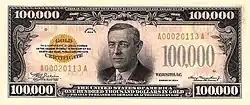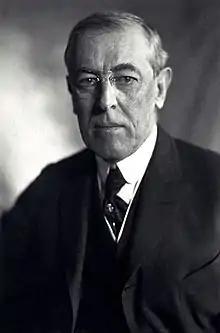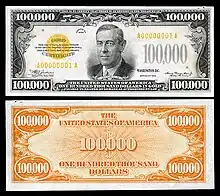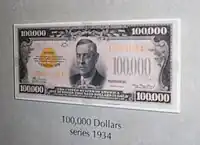| (United States) | |
|---|---|
| Value | $100,000 |
| Width | 157 (15.7 cm) mm |
| Height | 66 (6.6 cm) mm |
| Weight | (unspecified) g |
| Years of printing | 1934-1935 (commissioned in 1933) |
| Estimated value | $2,296,932 (1934 to 2023), $2,246,635 (1935 to 2023)[1] |
| Obverse | |
 | |
| Design | A vignette portrait of Woodrow Wilson |
| Design date | 1934 |
| Reverse | |
 | |
| Design | 100,000 centered in front of a US dollar sign, golden rays radiating out of the center, orange in color. |
| Design date | 1934 |
The United States one hundred thousand dollar bill (US$100,000) is a former denomination of United States currency, a gold certificate, issued for two years from 1934 to 1935 as designated for Federal Reserve use. The bill never circulated publicly, rather having been used as a large denomination note for gold transactions between Federal Reserve Banks.[2][3] Featuring President Woodrow Wilson, the $100,000 bill was initiated by the Bureau of Engraving and Printing under the order of President Franklin D. Roosevelt in response to the hoarding of gold during the Great Depression, believed to be slowing economic regrowth. Executive Order 6102, signed by President Roosevelt, was ratified by the United States Congress in 1934. Executive Order 6102 prohibited the hoarding of gold certificates, accompanied also by bullion and coins.[4]
Approximately 42,000 of the $100,000 bills were printed between 1934 and 1935. Many of the $100,000 bills were destroyed in the years following their commission, with the remaining few in possession of the United States federal government.[5] The $100,000 bill, in possession aside from the federal government, is deemed illegal on account of its large denomination and the regulations declared at its signing.[2][3][6] The bill, outside of the federal government, may only be used for educational purposes, particularly in museums for public viewing.[2] The Smithsonian Museum along with the Federal Reserve System are known to have one hundred-thousand-dollar bills in their ownership.[2]
Design

The $100,000 bill features a vignette portrait of President Woodrow Wilson,[6] in addition to the bolded, "This is to certify that there is on deposit in the Treasury of" on the upper portion of the note, followed by a cut-off on the lower portion, "the United States of America ... One hundred thousand dollars in gold payable to bearer on demand as authorized by law". "This certificate is legal tender in the amount thereof in payment of all debts and dues public and private" is further incorporated, located atop the Treasury seal. As a gold certificate, the bill exhibits little gold on the obverse: the Treasury seal and two serial numbers. The obverse also includes the words, "Washington D.C." in a bolded font. The reverse exhibits orange ink rather than gold, with a large "100,000" in front of a dollar sign. Orange rays extend from the center.[7]
The $100,000 bill is a part of the 1934 gold certificate series, comprising also the $100, $1,000, and $10,000 notes respectively.[6]


References
- ↑ https://www.officialdata.org/
- 1 2 3 4 "6 Discontinued and Uncommon U.S. Currency Denominations". Investopedia. Retrieved 2023-11-05.
- 1 2 "$100,000 Bill | Museum of American Finance". www.moaf.org. Retrieved 2023-11-05.
- ↑ "Learn the Facts About Gold Confiscation | U.S. Gold Bureau". www.usgoldbureau.com. Retrieved 2023-11-05.
- ↑ Ganninger, Daniel (2020-06-16). "There Really Was a $100,000 Bill". Knowledge Stew. Retrieved 2023-11-05.
- 1 2 3 "$100,000 Gold Certificate | Engraving & Printing". www.bep.gov. Retrieved 2023-11-05.
- ↑ "100,000 Dollars, Gold Certificate, United States, 1934". National Museum of American History. Retrieved 2023-11-05.